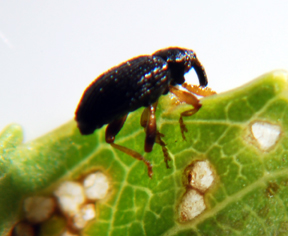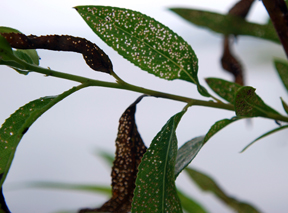Another tree pest causing concern
Editor’s note: This article is from the archives of the MSU Crop Advisory Team Alerts. Check the label of any pesticide referenced to ensure your use is included.
Jill O’Donnell reported near defoliation of some willow trees in Wexford County this past week. The responsible party was the willow flea weevil,Rhynchaenus sp. (Coleoptera: Curculionidae). This tiny little beetle chews small holes in the leaves while the larval stages feed inside leaves as a leafminer.
The adult flea weevils hibernate under loose bark or in ground litter. These overwintering adults emerge in early May and feed on opening buds and new leaves, eating circular holes, sometimes killing back twigs. The continued feeding of the adult weevils causes the foliage to become brown and dry. During the latter part of May or early June, they excavate circular mines or pits on the underside of the leaves and deposit their eggs. The eggs hatch and the larvae begin to mine the leaves in mid- to late June. The larvae pupate in the mined leaves in mid-summer and the adult weevils emerge in August. In heavier infestations, by early August the trees appear as though scorched by fire.
The willow flea weevil seems to prefer bayleaf (laurelleaf) willow, Salix pentandra, but it will also attack other willows, Lombardy poplar and aspens. Normally, the willow flea weevil is not a problem on weeping willow, except where grown in close proximity to bayleaf willow. Salix alba is often heavily infested in the countryside.
It is too late to do anything about this pest this year as the best time to attempt control is in the spring when the adults emerge and begin to feed on the expanding buds. Even then it is difficult to control this pest.



 Print
Print Email
Email




